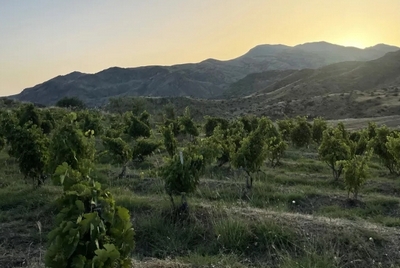The country’s indigenous old vine grapes allow producers to create wine unlike anywhere else in the world. Despite historical hurdles, they’ve only just begun.
Vines in Armenia are old. In fact, some of them are very old, dating back 150 years, and yet are still more than able to produce grapes for wine.
For the last ten years, Kristina Margaryan, head of the research of plant genomics at the Molecular Biology Institute of Armenia, has been cataloging lost and endangered indigenous varieties in every village and vineyard in Armenia’s Vayots Dzor region.
“Interviews with the farmers, and written records saved in the local municipalities and churches, reveal that there are 100-year-old and even older vineyards there,” says Margaryan. So far, she has documented about 3,000 genotypes, 300 of which are considered distinct varieties. To identify the grapes, her group works closely with the Julius Kuhn Institute in Germany, which hosts one of the biggest databases of grape genetic resources in the world.
When Armenia became part of the Soviet Union in 1922, winemaking shifted into collective farming, with grapes grown solely for brandy and dessert wine production. But some older vineyards, often at high elevation, were left uncultivated — and therefore spared for new generations who would revive the industry decades later in the independent Republic of Armenia.
The old vine project
Winemakers Artem Parseghyan and Gomidas Merjanian joined Trinity Canyon Vineyards in 2016 and immediately started experimenting with different ancient varieties. In 2020, they found an uncultivated 2.2-acre garden filled with fruit trees, bushes and Areni vines. The owner, in his seventies, told the winemakers that his grandfather had planted the vineyard; it was at least 120 years old, and one of the highest in the region at almost 5,000 feet above sea level.
“One of the advantages of viticulture in Armenia is effectively vertical grape growing,” says Parseghyan. “This allows vineyards in the same small location but at very different altitudes.” And those variations in terroir in such small areas allow for a distinctive complexity in the wines.
A Vibrant New Culinary Scene Is Rooted in Armenia’s Ancient Winemaking Culture
The two winemakers came up with different labels for their own wines (which are made at Trinity Canyon), both emphasizing the concept of a single vineyard. The name of Merjanian’s wine, Dzon, is a tribute to the beginning of winemaking traditions. Parseghyan’s, Hazarvaz, literally translates into “one thousand vines” — the number he has in his vineyard. “We always say that we have winemaking in our DNA. Artem and I wanted to go back and revive that history and heritage through these old vines,” says Merjanian.
Restoring the past
Tatevik Gabrielyan and Jean Paul Berger founded Krya Wines in Tatevik’s native village, Vernashen, after studying winemaking together in Switzerland. In 2017, with Tatevik’s father’s help, the couple started to acquire vineyards. This wasn’t easy — after the privatization of land in 1991, a small plot, or even separate rows of vines, might have multiple owners. The couple was finally able to purchase a small vineyard with two plots of fifty-five and seventy-five year old vines. “The vines were in really bad shape. Everyone advised us to take them out and replant them. But we wanted to preserve the old varieties and to see what they were capable of,” recalls Gabrielyan.
Reconstructing the vineyard took four years but resulted in a first harvest of the red Areni Noir, plus five indigenous white grape varieties: Voskehat, Mskhali, Chilar, White Areni and Khatun Kharji. Their Areni Noir has notes of wild berries, ripe cherries and hints of vanilla; the indigenous white blend is a pale, straw-yellow wine with aromas of citrus and fresh pear. Then, in 2022, the couple also started their “Poqr Krya” project (small Krya, basically) to help neighboring small vineyards with their harvests and produce a more affordable line of wines, also representing the region’s heritage.
Returning winemaking to the city
In the 19th century, Armenia’s capital city of Yerevan had almost 200 cellars that catered to travelers. Norqi Keghar Winery, one of the four that remain, was founded in 1877 by Hovhannes Derdzakyan, an orphan survivor of the Armenian Genocide. He had been adopted by a local couple who owned land in Norq, one of the oldest neighborhoods in the city, and eventually planted five acres of the indigenous variety Voskehat there, and built a house and cellar as well. In the 1920’s, he was forced to hand over the vineyard to the Soviets; he kept only the 150-year-old Khachabash vines that were growing in his backyard. But in 2019 his grandchildren together with two close friends decided they should make wine once again, using the remaining old vines and harvesting old-vine fruit as well from the Vayots Dzor, Aragatsotn and Armavir regions.
“We decided to give a breath of fresh air to this story,” says Artsrun Petrosyan, one of the cofounders of Norqi Keghar. “It was a way of life for our ancestors, but it was never allowed to reach the level of what they have, let’s say, in France. But with this project we are trying to change that.”
Norqi Keghar Winery makes 80 to 100 bottles of that ancient Khachabash, aging it in the 150 years old clay amphoras in the ideally preserved cellar. Recently, they also acquired a neighboring winery, which was built in 1881.
Admittedly, the market for the wines made from these ancient vines is mainly domestic — the amounts are very small, and worldwide awareness of the different varieties that grow here is minimal. Artem Parseghyan and Gomidas Merjanian do export a small quantity to France and Russia, and plan to have a representation in Brazil as well. Krya Wines are in Russia and Estonia, so far. But perhaps that’s a reason for wine-lovers to add Armenia to their list of someday-I-will-get-there destinations.
by Ani Duzdabanyan
Credits: foodandwine.com

